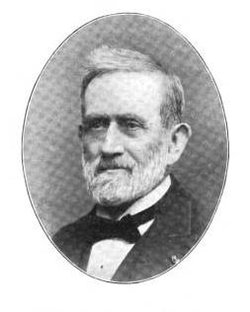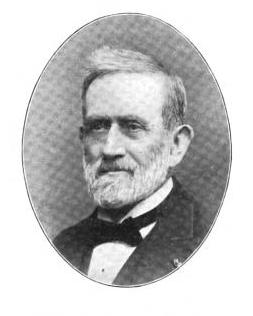--Chicago Tribune, 23 Mar 1898, pg. 10
Brother of "Grace Greenwood"
Married (1) Jan. 25, 1859, Harriet Hale of Marshall, Mich., born Sept. 1836, and died June 20, 1864; (2) Mary Louise Reed, Dec. 26, 1865.
Dr. Clarke was Surgeon of the 4th and 19th Michigan Infantry, and was later stationed at Carver Hospital.
The above information was provided by Debbie B before she so kindly transferred the website to me (BZS).
Who discovered surgical anesthesia? Who first performed a surgical procedure under general anesthesia? Who administered the first use?
The answer to the first question has been a matter of considerable debate and may never be satisfied to everyone's expectations. The main candidates being Dr. Horace Wells (1815-1848, FAG Memorial# 5820828), a dentist of Hartford., Connecticut who is credited with the discovery of nitrous oxide as an anesthetic; Dr. William Thomas Green Morton (1819-1868, FAG Memorial# 1759), a dentist and former partner of Wells who first demonstrated the use of sulfuric ether (which he termed Letheon) in a surgical operation; and Dr. Charles Thomas Jackson (1805-1880, FAG Memorial# 6688269), a physician and chemist who suggested the use of sulfuric ether to Morton.
Some years after the discovery was made and many patients all over the world were benefiting from painless surgery, Dr. Crawford Williamson Long (1815-1878, FAG Memorial# 7311270) staked a claim to the discovery, but because he had not published his work or announced it in any way, he was denied the assertion that he was the discoverer of surgical anesthesia by most historians and particularly medical historians.
In the end Crawford Long became known for being the first to use ether as an anesthetic, but was he? In his 1881 work entitled "Artificial Anaesthesia and Anaesthetics," Professor Henry Munson Lyman (1835-1904, FAG Memorial# 114693738), documented an occurrence and introduced us to two names of physicians who some medical historians have said have a greater claim to this honor than Crawford Long. They were Elijah Pope (1818-1856, FAG Memorial# 69242001), a medical doctor who limited his practice to dentistry and William E. Clarke (1819-1898, FAG Memorial# 95575367).
Dr. Lyman described the event thus: "During the year 1839 a young student of chemistry in the city of Rochester, New York, William E. Clarke, by name, now a veteran physician of Chicago, was in the habit of entertaining his companions with inhalations of ether. At Berkshire Medical College, during the winter of 1841-1842 Clarke diligently propagated this convivial method among his fellow students. Emboldened by these experiences in January, 1842, having returned to Rochester, he administered ether from a towel to a young woman named Hobbie and one of her teeth was then extracted without pain by a dentist named Elijah Pope."
So far as has been ascertained this is the first historic account of the successful administration of ether, resulting in a painless surgical operation of any sort.
Therefore according to the research of Dr. Lyman, Dr. Elijah Pope was the first to perform a surgical procedure under general anesthesia and Dr. William Edwin Clarke was the first to administer the ether. I prefer to think of them as a team. Dr. Pope died before Dr. Lyman's research was published.
--Chicago Tribune, 23 Mar 1898, pg. 10
Brother of "Grace Greenwood"
Married (1) Jan. 25, 1859, Harriet Hale of Marshall, Mich., born Sept. 1836, and died June 20, 1864; (2) Mary Louise Reed, Dec. 26, 1865.
Dr. Clarke was Surgeon of the 4th and 19th Michigan Infantry, and was later stationed at Carver Hospital.
The above information was provided by Debbie B before she so kindly transferred the website to me (BZS).
Who discovered surgical anesthesia? Who first performed a surgical procedure under general anesthesia? Who administered the first use?
The answer to the first question has been a matter of considerable debate and may never be satisfied to everyone's expectations. The main candidates being Dr. Horace Wells (1815-1848, FAG Memorial# 5820828), a dentist of Hartford., Connecticut who is credited with the discovery of nitrous oxide as an anesthetic; Dr. William Thomas Green Morton (1819-1868, FAG Memorial# 1759), a dentist and former partner of Wells who first demonstrated the use of sulfuric ether (which he termed Letheon) in a surgical operation; and Dr. Charles Thomas Jackson (1805-1880, FAG Memorial# 6688269), a physician and chemist who suggested the use of sulfuric ether to Morton.
Some years after the discovery was made and many patients all over the world were benefiting from painless surgery, Dr. Crawford Williamson Long (1815-1878, FAG Memorial# 7311270) staked a claim to the discovery, but because he had not published his work or announced it in any way, he was denied the assertion that he was the discoverer of surgical anesthesia by most historians and particularly medical historians.
In the end Crawford Long became known for being the first to use ether as an anesthetic, but was he? In his 1881 work entitled "Artificial Anaesthesia and Anaesthetics," Professor Henry Munson Lyman (1835-1904, FAG Memorial# 114693738), documented an occurrence and introduced us to two names of physicians who some medical historians have said have a greater claim to this honor than Crawford Long. They were Elijah Pope (1818-1856, FAG Memorial# 69242001), a medical doctor who limited his practice to dentistry and William E. Clarke (1819-1898, FAG Memorial# 95575367).
Dr. Lyman described the event thus: "During the year 1839 a young student of chemistry in the city of Rochester, New York, William E. Clarke, by name, now a veteran physician of Chicago, was in the habit of entertaining his companions with inhalations of ether. At Berkshire Medical College, during the winter of 1841-1842 Clarke diligently propagated this convivial method among his fellow students. Emboldened by these experiences in January, 1842, having returned to Rochester, he administered ether from a towel to a young woman named Hobbie and one of her teeth was then extracted without pain by a dentist named Elijah Pope."
So far as has been ascertained this is the first historic account of the successful administration of ether, resulting in a painless surgical operation of any sort.
Therefore according to the research of Dr. Lyman, Dr. Elijah Pope was the first to perform a surgical procedure under general anesthesia and Dr. William Edwin Clarke was the first to administer the ether. I prefer to think of them as a team. Dr. Pope died before Dr. Lyman's research was published.
















